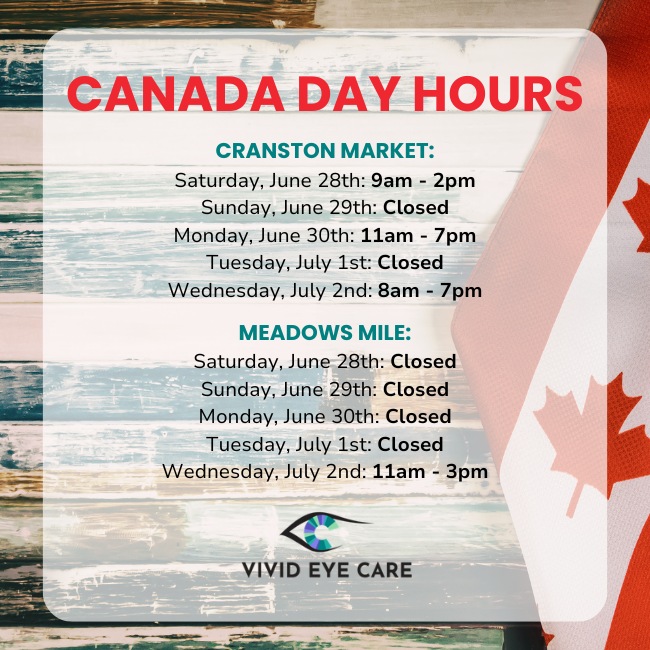There are many different eye conditions someone can experience and many can emerge in childhood. They typically require an optometrist’s care and regular eye exams are important for diagnosing any potential problems. Learn more about common eye problems in infants, toddlers, and children below.
Common Eye Problems in Children
Refractive Errors
Refractive errors are a failure of the eye to focus an image sharply. They are the leading causes of blurred vision. There are three types of refractive error:
Each variant affects the eye differently. Regular eye exams can help diagnose a refractive error and an optometrist can provide the correct prescription for your child.
Nearsightedness (Myopia)
Myopia causes far away objects to appear blurry while nearby objects are seen clearly. It is a common condition and can develop gradually or rapidly. Symptoms of myopia in children include:
- Excessive blinking
- Frequent eye rubbing
- Persistent squinting
- Sitting closer to the television & other screens
Farsightedness (Hyperopia)
Hyperopia, a common condition, causes nearby objects to appear blurry or requires a lot of effort to make clear, while far away objects appear more clearly. Farsightedness is typically present from birth. Symptoms of hyperopia can include:
- Squinting to see clearly
- Eyestrain, headaches or discomfort during close-up tasks such as reading & writing
- Difficulty seeing nearby objects
Astigmatism
Astigmatism, an imperfection within the eye, causes blurry vision from near and far distances. It occurs when the cornea or the lens has mismatched curves. Symptoms can include:
- Squinting
- Eyestrain
- Headaches
This condition is usually present at birth, and a child may not realize their vision is blurry or abnormal. An eye exam can diagnose astigmatism and an optometrist can recommend the most effective treatment for your child.
Conjunctivitis (Pink Eye)
Conjunctivitis, also known as pink eye, can be very common in children. This condition is typically contagious and can spread through schools and playgrounds relatively easily. There are three main variants of conjunctivitis:
- Bacterial
- Viral
- Allergic
Bacterial and viral cases of pink eye are contagious, but allergic conjunctivitis is not. The treatment of pink eye depends on the variant your child is experiencing.
Bacterial Conjunctivitis
Bacterial conjunctivitis is generally caused by bacteria infecting the eye through a source of contamination. This contact can be an infected person, a contaminated surface, or another source, such as a sinus infection.
Antibiotics are the most effective treatment for bacterial infection. Antibiotic eye drops or ointments may be used to treat this variant of conjunctivitis.
Viral Conjunctivitis
Viral conjunctivitis is another contagious form of pink eye. It’s typically caused by airborne viruses being spread through sneezing and coughing. Viral conjunctivitis can be present alongside respiratory infections such as the common cold and the flu.
Viral conjunctivitis typically resolves itself after a short period. Treatment is usually supportive to help reduce symptoms. Decongestants may be used to reduce swelling, and antihistamines to reduce any itching.
Allergic Conjunctivitis
Allergic conjunctivitis is caused by eye allergies. This variant of conjunctivitis is not contagious and is typically triggered by allergens such as pollen, dust mites, and dander. Itchy eyes are the most common symptom of allergic conjunctivitis.
Antihistamines can be effective to reduce any symptoms your child experiences. Avoiding allergen sources is important as well. Understand the sources of your child’s allergies and you can reduce the risk of allergic conjunctivitis.
Strabismus (Crossed Eyes)
Strabismus is a muscle condition where the eyes are not properly aligned. This can happen when one or both of the eyes turns inward, outward, upward, or downward. Strabismus causes double vision or suppression of the image from the affected eye.
Children under six are most affected by strabismus. You may notice one or both of your child’s eyes wandering. A comprehensive eye exam can diagnose strabismus, and a treatment plan is recommended if the condition is present. Treatment can include:
- Eyeglasses
- Vision therapy
- Surgery if needed
Amblyopia (Lazy Eye)
Amblyopia, also known as lazy eye, is caused by abnormal visual development early in life. This condition may present no initial symptoms when one eye has clear vision. This eye will generally become dominant in visual tasks and a child may not know they have amblyopia because of this.
A comprehensive eye exam can determine the presence of amblyopia. This condition typically requires treatment to strengthen the weaker eye. An optometrist may recommend some of the following:
- Prescriptive eyeglasses
- Eye drops to strengthen the weaker eye
- An eye patch to cover the dominant eye
- Surgery if needed
There are many possible eye conditions your child may be affected by, but how do you know when a trip to the optometrist is needed?
Symptoms of Eye Problems in Children
It can be difficult to determine whether or not your child is displaying symptoms of an eye condition. It is important to remain vigilant of their ocular health, and if you notice any of these recurring symptoms, a visit to the eye doctors should be scheduled:
- Persistent eye rubbing
- Covering one or both eyes
- Avoiding detail-oriented activities (colouring, puzzles)
- Drooping or misaligned eyes
- Indoor or outdoor light sensitivity
- Looking too closely at books & screens
- Head tilting
- Clumsiness
- Eye redness, discharge or excessive tearing
If your child is experiencing any persistent symptoms, an eye exam can help diagnose any potential problems. Regular examinations can pinpoint any possible eye conditions and prevent the worsening of any undiagnosed problems.
We’re Here to Help
Your child should first be examined at six months old and annually after this. Many children require vision correction at an early age, and an undiagnosed condition can affect your child’s quality of life and ability to focus.
Whether your child is experiencing symptoms of a potential eye condition or simply needs their regular exam, book an appointment with your optometrist. Children’s eye exams are covered by Alberta Health Care. Vivid Eye Care’s optometrists and team are here for you and your family.























